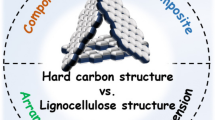Abstract
Various types of sodium cellulose sulfate (SCS), dissolved in a 1M LiCl solution, were investigated by alternating current (AC)polarography. The SCS samples differed in the degree of substitution (DS), thedistribution of substituents within the anhydroglucose unit (AGU), and alongthechain, due to the method of synthesis. The goal was to study theelectrosorptionbehavior, characterized by the shape of the desorption wave in the polarogram,as a function of the chemical structure of the SCS samples. The shape of thedesorption wave reflects domains of different substitution. A superimpositionofparameters like DS and pattern of substitution on the electrosorption behaviorwas observed. The AC polarography method described can be used as a tool todistinguish between an even or uneven distribution of substituents along thecellulose chain.
Similar content being viewed by others
References
Alsleben H., Jehring H., Philipp B. and Dautzenberg H. 1971.Wechselstrompolarographische Untersuchungen an Carboxy-methylcellulosen. Faserforsch. Textiltechnik 22: 581–586.
Bard A.J. and Faulkner L.R. 1980. Electrochemical Methods. Wiley & Sons, New York, Appendix B.
Fischer K., Schmidt I. and Hintze H. 1994. Untersuchungen zur Substituentenverteilung in Cellulosexanthogenat. Papier 48: 769–773.
Gohdes M. and Mischnick P. 1998. Determination of the substitution pattern in the polymer chain of cellulose sulfates. Carbohydr. Res. 309: 109–115.
Gohdes M., Mischnick P. and Wagenknecht W. 1997. Methylation analysis of cellulose sulphates. Carbohydr. Polymers 33: 163–168.
Heinze Th. 1998. New ionic polymers by cellulose functionalization. Macromol. Chem. Phys. 199: 2341–2364.
Jehring H. 1974. Mischadsorption. In: Jehring H. (ed.), Elek-trosorptionsanalyse mit der Wechselstrompolarographie. Aka-demie-Verlag, Berlin.
Klemm D., Heinze T., Philipp B. and Wagenknecht W. 1997. New approaches to advanced polymers by selective cellulose functionalization. Acta Polymerica 48: 277–297.
Jaseja M., Rej R.N., Sauriol F. and Perlin A.S. 1989. Novel regio-and stereoselective modifications of heparin in alkaline solu-tion. Nuclear magnetic resonance spectroscopic evidence. Can. J. Chem. 67: 1449–1456.
Lukanoff B. and Dautzenberg H. 1994. Natriumcellulosesulfat als Komponente für die Erzeugung von Mikrokapseln durch Poly-elektrolytkomplexbildung. 1. Mitt. Heterogene Sulfatierung von Cellulose unter Verwendung von Schwefelsäure/Propanol als Reaktionsmedium und Sulfatiermittel. Papier 48: 287–296.
Mischnick P. and König W.A. 1991. Bestimmung der Substituen-tenverteilung modifizierter Polysaccaride durch chemischen Abbau und Gaschromatographie/Massenspektrometrie. Papier 45: 757–764.
Mischnick P. and Kühn G. 1996. Model studies on methyl amyloses: correlation between reaction conditions and primary structure. Carbohydr. Res. 290: 199–207.
Mota A.M., Simoes Goncalves M.L., Farinha J.P. and Buffle J. 1994a. Adsorption of poly(ethylene glycol)s on mercury/aqueous solution interface. 1. Kinetics of PEG 8000 adsorption. Colloids Surfaces A 90: 271–278.
Mota A.M., Simoes Goncalves M.L., Farinha J.P. and Buffle J. 1994b. Adsorption of poly(ethylene glycol)s on mercury/aqueous solution interface. 2. Influence of the chain length. Colloids Surfaces A 90: 279–283.
Nehls I., Wagenknecht W., Philipp B. and Stscherbina D. 1994.Characterization of cellulose and cellulose derivatives in solution by high resolution carbon-13 C-NMR spectroscopy. Progr. Polymer Sci. 19: 29–78.
Philipp B., Klemm D. and Heinze U. 1999. Cellulose. Regioselective cellulose chemistry: a challenge to cellulose research and development at the end of this century. Polymer News 24: 305–308.
Puls J., Horner S., Kruse T. and Saake B. 1998. Enzymunterstützte Charakterisierung von Carboxymethylcellulosen mit herkömm-licher und neuartiger Verteilung der funktionellen Gruppen. Papier 52: 743–748.
Reiche B., Jehring H. and Philipp B. 1978a. Untersuchungen zum Elektrosorptionsverhalten verschiedener Cellulose-und Stärke-derivate. Cellulose Chem. Technol. 12: 573–584.
Reiche B., Jehring H., Dautzenberg H. and Philipp B. 1978b. Elek-trosorptionsuntersuchungen an Carboxymethylcellulosen. Faserforsch. Textiltechnik 29: 324–328.
van Boeckel S., Meuleman D., Westerduin P., Vrijhof P. and Houdenhoven F. 1997. Heparin research at Organon-Diosynth. Carbohydr. Europe 16: 14–23.
Wagenknecht W., Nehls I., Klemm D. and Philipp B. 1992. Synthesis and substitution distribution of Na-cellulose sulphates via O-trimethylsilyl cellulose as intermediate. Acta Polymerica 43: 266–269.
Wagenknecht W., Nehls I. and Philipp B. 1993. Studies on the regioselectivity of cellulose sulfation in an N 2 O 4-N,N-dimethyl-formamide-cellulose system. Carbohydr. Res. 240: 245–252.
Wagenknecht W. 1996. Regioselektive Cellulosederivate durch Modifizierung technischer Celluloseacetate. Papier 50: 712–720.
Author information
Authors and Affiliations
Rights and permissions
About this article
Cite this article
Schuldt, U., Wagenknecht, W. & Richter, A. Electrosorption of sodium cellulose sulfates with different substitution patterns. Cellulose 9, 271–282 (2002). https://doi.org/10.1023/A:1021168425119
Issue Date:
DOI: https://doi.org/10.1023/A:1021168425119




